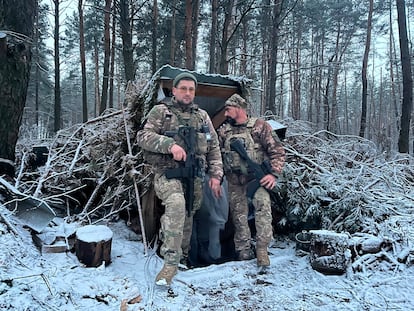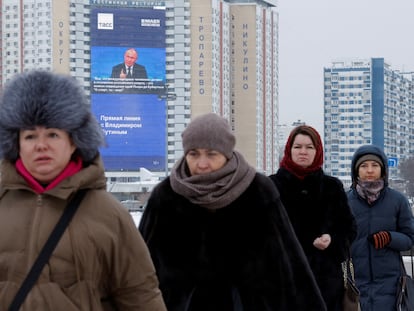The other war the West is not winning: Russia imports as much battlefield material as before Ukraine invasion
Russia’s average monthly expenditure on imports of battlefield goods from January to October 2023 stood at $932 million, only 10% less than the Kremlin was spending before sanctions
Over a 48-hour period when Ukrainian President Volodymyr Zelenskiy was busy on a tour through the Baltic countries, asking for more help to defeat Russia on the front line, and NATO, meeting on Wednesday in Brussels, committed itself to spending “billions” on military assistance to Kyiv, Moscow spent a sum of around $61 million on the purchase of war material, despite the trade restrictions imposed by the West following its full-scale invasion on February 24, 2022. According to a report released Thursday by the Kyiv School of Economics (KSE) and the Yermak-McFaul Group — led by Ukrainian presidential chief of staff Andrii Yermak and former U.S. ambassador Michael McFaul — Russian imports of war goods have largely recovered from their sharp drop following the imposition of export controls.
The study, prepared by monitoring trade databases, puts Russia’s average monthly expenditure on imports of battlefield goods (communications equipment, electronic components, or semiconductors for military use, among others) from January to October 2023 at $932 million, only 10% less than the Kremlin was spending before the sanctions.
Moreover, 48.5% of these goods originated from one of the countries of the coalition that imposed the restrictions. That does not mean that the seller, be it the United States, Australia, Japan, the United Kingdom, or any member state of the European Union, knowingly deals with Russian companies, but that the trail of the sales is lost in a complex web until it reaches third countries, that is to say, Moscow’s direct partners such as, above all, China, which dominates all the sections in the mapping of imports of such goods to Russia as a producer country (47%), country of origin (66%), seller (40%) or country of product delivery (56%). Turkey and the United Arab Emirates are also highlighted in the report.
The report notes, however, that the purchase of other products that are fundamental to Moscow’s war machine — albeit dual-use civilian or military — has fallen by more than 28%, from $3.17 billion per month before February 2022 to $2.29 billion on average in the first 10 months of last year. In other words, as KSE senior researcher Olena Bilousova points out, export controls after the invasion are having an effect. “They force Russia to look for new trade routes and thus spend more money.” But it is still not enough. “If new measures are passed, we would have more effect,” Bilousova continues, “but if we stop, we would lose what we have achieved so far.” Among the recommendations of the study is the coordinated effort of the sanctioning countries, among public and financial institutions, companies, and even civil society. The analyst says that “a framework similar to that of the international control of money-laundering” should be implemented.
The report is relevant not only in what it reveals, but also in its timing. Once the full-scale invasion of Ukraine began a coalition of countries including the US, the UK, EU member states, Japan, Australia, Canada, and South Korea extended an unprecedented web of export controls on Russia, extending the scope of the measures adopted after the illegal annexation of Crimea and the invasion of the Donbas region in 2014. By then, Russia had stockpiles and its industry was already tuned to war — the purchase of battlefield goods skyrocketed in late 2021 when the invasion was being prepared — so any sanctions were going to take time to take effect. “But any kind of delay [in the effects] is over,” Bilousova warns. Either sanctions work or they don’t.
Change in trade routes
What is certain, according to the KSE and Yermak-MacFaul Group research, is that, thanks to export restrictions, Russia has suffered shortages of some valuable products manufactured by Western companies, especially in the electronics sector, and that trade routes for these materials have been altered. Bilousova points out how, for example, the analysis of trade databases has allowed them to identify changes in the group of Chinese suppliers to Russia as companies from the Asian giant have been added to the U.S. Department of Commerce blacklist; or how a country allied with Russia such as Kazakhstan went from zero imports of semiconductors before the war to multiplying its purchases as of February 2022.
Although the effects are moderate, vigilance from the West continues. For example, 42 new companies were added to the U.S. blacklist on December 6 for supplying the Russian army, including material to produce drones, together with Iran, in new facilities in Tatarstan. Among the blacklisted companies were four based in Cyprus, three in Belgium, one in Germany, and one in the Netherlands. As a result of this move, Belgian businessman Hans De Geetere, 61, was arrested in an operation between Belgian authorities and the FBI.
A report titled Challenges in the Application of Export Controls highlights the possibility under U.S. law of pursuing products which, although they do not come from a U.S.-based manufacturer, contain a component, however small, of U.S. origin in their assembly. But theory and practice are two different things. The Ukrainian National Agency on Corruption Prevention has identified 2,800 parts in weapons used by Russia such as missiles, drones, and military vehicles. Of these, 95% come from producers in coalition countries; 72% originate in the United States.
One of these companies is Texas Instruments. An internal Ukrainian government report to which EL PAÍS has had access identifies Texas Instruments products in components of the Shahed drones used by Russia. In April last year, and in view of the information on the arrival of the company’s microchips on the Russian market despite sanctions, the technology company’s board voted against internally reinforcing the control of the improper use of its products.
Sign up for our weekly newsletter to get more English-language news coverage from EL PAÍS USA Edition










































